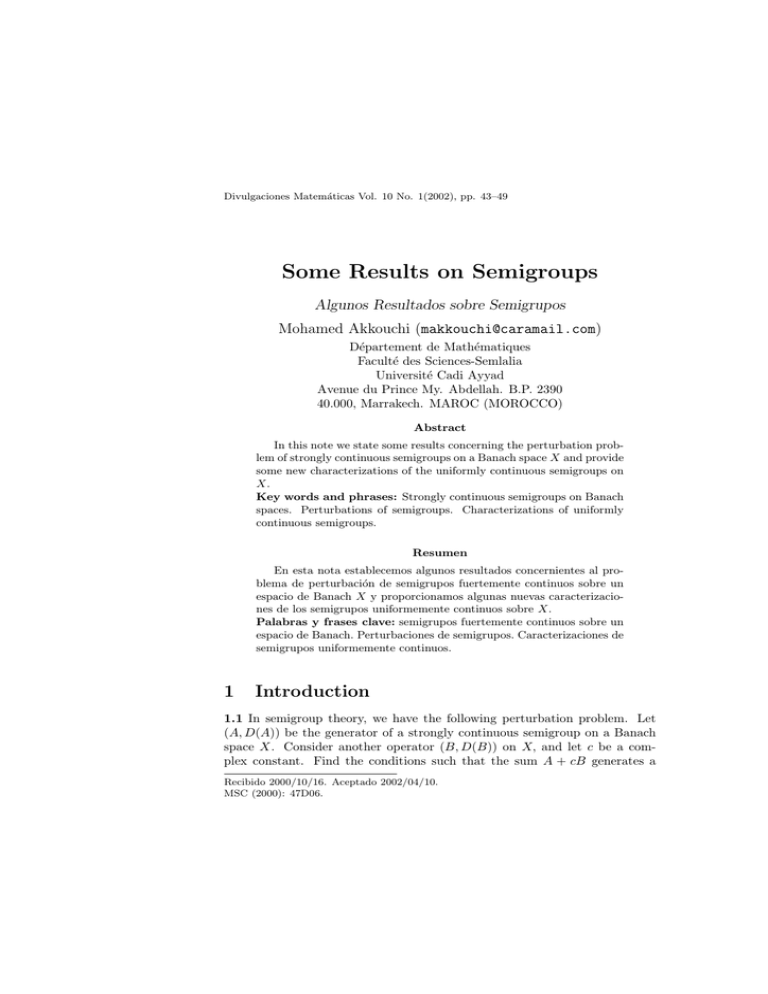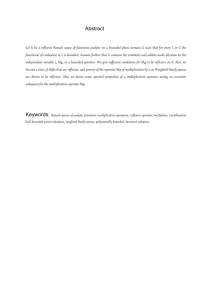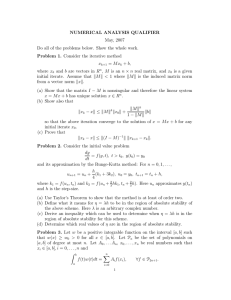Some Results on Semigroups Algunos Resultados sobre Semigrupos Mohamed Akkouchi ()
advertisement

Divulgaciones Matemáticas Vol. 10 No. 1(2002), pp. 43–49
Some Results on Semigroups
Algunos Resultados sobre Semigrupos
Mohamed Akkouchi (makkouchi@caramail.com)
Département de Mathématiques
Faculté des Sciences-Semlalia
Université Cadi Ayyad
Avenue du Prince My. Abdellah. B.P. 2390
40.000, Marrakech. MAROC (MOROCCO)
Abstract
In this note we state some results concerning the perturbation problem of strongly continuous semigroups on a Banach space X and provide
some new characterizations of the uniformly continuous semigroups on
X.
Key words and phrases: Strongly continuous semigroups on Banach
spaces. Perturbations of semigroups. Characterizations of uniformly
continuous semigroups.
Resumen
En esta nota establecemos algunos resultados concernientes al problema de perturbación de semigrupos fuertemente continuos sobre un
espacio de Banach X y proporcionamos algunas nuevas caracterizaciones de los semigrupos uniformemente continuos sobre X.
Palabras y frases clave: semigrupos fuertemente continuos sobre un
espacio de Banach. Perturbaciones de semigrupos. Caracterizaciones de
semigrupos uniformemente continuos.
1
Introduction
1.1 In semigroup theory, we have the following perturbation problem. Let
(A, D(A)) be the generator of a strongly continuous semigroup on a Banach
space X. Consider another operator (B, D(B)) on X, and let c be a complex constant. Find the conditions such that the sum A + cB generates a
Recibido 2000/10/16. Aceptado 2002/04/10.
MSC (2000): 47D06.
44
Mohamed Akkouchi
strongly continuous semigroup on X. The purpose of this paper is twofold.
The first purpose is to provide some answers to this problem. The results
obtained in are established in Section 2. The second purpose is to provide
some new characterizations of uniformly continuous semigroups on X. These
characterizations are established in Section 3. The section four contains some
observations and remarks in connection with the results obtained in the sections 2 and 3. For the sequel, we need to make some recalls and notations.
1.2 Let (X, k.k) be a (complex) Banach space. Let (A, D(A)) be a (possibly
unbounded) operator on X. Consider a second operator (B, D(B)) on X. We
say (see [1]) that B is (relatively) A-bounded if D(A) ⊂ D(B) and if there
exist positive constants a, b such that
kBxk ≤ a kAxk + b kxk ,
(1.1)
for all x in the domain D(A) of A. The space D(A) will be endowed with the
norm kxkA := kAxk + kxk . A subset D of D(A) will be called a core of A if
it is dense in D(A) equipped with the norm k.kA .
Suppose now, that (A, D(A)) is the generator of a bounded strongly continuous semigroup (T (t))t≥0 on X. Then (see [2], p. 7) A verifies the LandauKolmogorov inequality, that is
°
°
2
kAxk ≤ 4M 2 °A2 x° kxk , ∀x ∈ D(A2 ),
(1.2)
where M is a positive constant such that supt≥0 kT (t)k ≤ M. We set D(A∞ ) :=
∩n≥1 D(An ). We recall (see [1], p. 53) that D(A∞ ) is a core of A and that
D(An ) is a core of A for every integer n ≥ 1.
2
Some results on perturbations of semigroups
The purpose of this section is to provide some results in connection with the
perturbation problems of semigroups on Banach spaces. Our main result in
this area of investigations is the following.
2.1 Theorem: Let (A, D(A)) be the infinitesimal generator of a strongly
continuous semigroup (T (t))t≥0 on the Banach space X. Let (B, D(B)) be a
second operator on X verifying the following assumptions
(H1 ) R(B) ⊂ D(A), where R(B) is the range of B.
(H2 ) The set D := D(B ∞ ) is a core of A such that
°
°
2
kBxk ≤ °B 2 x° kxk , ∀x ∈ D.
(2.1)
Divulgaciones Matemáticas Vol. 10 No. 1(2002), pp. 43–49
Some results on Semigroups
45
(H3 ) B is A-bounded.
(H4 ) A ◦ B is B-bounded.
Then B and A ◦ B are bounded on X. Consequently, the operators (A +
cB, D(A)) and (A + cA ◦ B, D(A)) are generators of strongly continuous semigroups on X for every complex number c.
Proof: a) replacing x by B n−1 x in (2.1), we deduce
°
°°
°
2
kB n xk ≤ °B n+1 x° °B n−1 x° , ∀x ∈ D, and ∀n ∈ N∗ ,
(2.2)
where N∗ is the set of all strictly positive integers. By induction (2.2) yields
to
°
°
2
kB n xk ≤ °B 2n x° kxk , ∀x ∈ D, and ∀n ∈ N∗ .
(2.3)
The assumptions (H3 ) and (H4 ) will ensure the existence of four positive
constants a1 , a2 , b1 , b2 such that
kBxk ≤ a1 kAxk + b1 kxk ∀x ∈ D,
kA ◦ Bxk ≤ a2 kAxk + b2 kxk ∀x ∈ D.
(2.4)
From the last inequalities, we obtain
kBxkA ≤ a kAxk + b kxk ∀x ∈ D,
(2.5)
where a = a1 (1 + a2 ) and b = (1 + a2 )b1 + b2 . Since D is a core of A,
we deduce from (2.5) that the operator B : (D(A), kkA ) −→ (D(A), kkA ) is
bounded. Thus we can find a positive constant β such that
kBxkA ≤ βkxkA , ∀x ∈ D(A).
(2.6)
b) By using (2.3) we get, for every integer n and every x ∈ D, the following
inequalities
° n °2
° n+1 °
° 2 °
°
°
≤ °B 2 x° kxk ,
°B x°
° n−1 °22
° n °2
° 2
°
°
°
2
x°
≤ °B 2 x° kxk ,
°B
············ ··· ···············
°
°2n
2n+1
2n
kBxk
≤ °B 2 x° kxk .
These inequalities allow us to deduce
° n+1 °
°
°
2n+1
2n+1 −1
kBxk
≤ °B 2 x° kxk
, ∀x ∈ D and ∀n ∈ N.
Divulgaciones Matemáticas Vol. 10 No. 1(2002), pp. 43–49
(2.7)
46
Mohamed Akkouchi
For every x ∈ D \ {0}, we get from (2.6) and (2.7) the following inequality
·
¸ 1
kxkA 2n+1
kBxk
≤β
, ∀n ∈ N.
kxk
kxk
(2.8)
Letting n → ∞ in (2.8), we conclude that
kBxk ≤ β kxk , ∀x ∈ D.
(2.9)
Since D is a core of A then it is dense in D(A). Hence, (2.9) says that the
operator B extends in a unique manner to the whole space X in a bounded
operator. From (2.4), we deduce that A ◦ B extends in a unique manner to
X in a bounded operator. The remainder is a consequence from the general
theory of semigroups (see Theorem 1.3, p. 158 in [1]).
2.2 Corollary: Let H be a Hilbert space endowed with the inner product
<, >, and let (A, D(A)) be the infinitesimal generator of a strongly continuous
semigroup (T (t))t≥0 on H. Let (B, D(B)) be a second operator on H verifying
(H1 ), (H3 ), (H4 ) together with the following assumption
(H2 )0 < Bx, y >=< x, By >, for all x, y ∈ D , where D is a core of A
contained in the set D(B ∞ ).
Then B and A ◦ B are bounded on X. Consequently, the operators (A +
cB, D(A)) and (A + cA ◦ B, D(A)) are generators of strongly continuous semigroups on X for every complex number c.
Proof: It is sufficient to see that (H2 )0 implies (H2 ). But this is an easy
consequence of the Cauchy-Schwarz inequality applied to the hermitian form
F : D × D −→ C given by F (x, y) :=< Bx, By > .
2.3 Remark: The previous results are valid if we replace the assumptions
(H3 ) and (H4 ) by the following assumptions
(H3 )0 D(A) ⊂ D(B), and
(H4 )0 the operator B : (D(A), k.kA ) −→ (D(A), k.kA ) is bounded.
3
Characterizations of uniformly continuous
semigroups
The purpose of this section is to establish some new characterizations for the
uniformly continuous semigroups on Banach spaces. Our first result is the
following.
Divulgaciones Matemáticas Vol. 10 No. 1(2002), pp. 43–49
Some results on Semigroups
47
3.1 Theorem: Let (A, D(A)) be the infinitesimal generator of a strongly
continuous semigroup (T (t))t≥0 on the Banach space X. Then the following
assertions are equivalent.
(1) The semigroup (T (t))t≥0 is uniformly continuous.
(2) The operator A : (D(A2 ), k.kA ) −→ (D(A), k.kA ) is bounded.
(3) The operator A2 : (D(A2 ), k.kA ) −→ (X, k.k) is bounded.
Proof: a) We know that there exist constants ω ∈ R and M ≥ 1 such that
kT (t)k ≤ M eωt
(3.1)
for all t ≥ 0. Then replacing A by A−ωI, we may suppose that supt≥0 kT (t)k ≤
M.
b) Suppose that (1) holds true. Then D(A) = D(A∞ ) = X and A ∈ L(X)
the Banach space of all bounded operators on X. Then for every x ∈ X, we
have kAxkA ≤ [1 + kAk]kxkA . Thus (2) is true.
c) Suppose that (2) °holds°true. Then there exists a positive constant C > 0
such that kAxkA = °A2 x° + kAxk ≤ C[kAxk + kxk] for all x ∈ D(A2 ). This
inequality implies (3).
d) Suppose° that° (3) holds true. Then there exists a positive constant C > 0
such that °A2 x° ≤ C[kAxk + kxk] for all x ∈ D(A2 ). By using the LandauKolmogorov inequality we deduce that there exists another positive constant
2
designated again by C such that kAxk ≤ C[kAxk+kxk] kxk for all x ∈ D(A2 ).
Let us denote SD(A2 ) the set of unit vectors in D(A2 ). Then we have
2
kAuk − C kAuk − C ≤ 0,
for all u ∈ SD(A2 ) . Since the set S of numbers s ∈ [0, ∞[ verifying s2 −Cs−C ≤
√
C+ C[C+4]
0 is bounded by the constant
we deduce that supu∈SD(A2 ) kAuk is
2
finite, which means that A is bounded, hence (1) is true.
By induction and similar arguments to those used in the proof of Theorem
3.1, one can establish the following
3.2 Theorem: Let (A, D(A)) be the infinitesimal generator of a strongly
continuous semigroup (T (t))t≥0 on the Banach space X. Then the following
assertions are equivalent.
(1) The semigroup (T (t))t≥0 is uniformly continuous.
(2) For all integer n ∈ N∗ , the operator An : (D(An+1 ), k.kA ) −→ (D(A), k.kA )
is bounded.
Divulgaciones Matemáticas Vol. 10 No. 1(2002), pp. 43–49
48
Mohamed Akkouchi
(3) There exists at least an integer n ∈ N∗ , such that the operator An :
(D(An+1 ), k.kA ) −→ (D(A), k.kA ) is bounded.
(4) For all integer n ∈ N∗ , the operator An : (D(An ), k.kA ) −→ (X, k.k) is
bounded.
(5) There exists at least an integer n ∈ N∗ , such that the operator An :
(D(An ), k.kA ) −→ (X, k.k) is bounded.
4
Remarks
Let X be a Banach space and let let (A, D(A)) be the infinitesimal generator
of a strongly continuous semigroup (T (t))t≥0 on X verifying kT (t)k ≤ M
for all t ≥ 0, where M is a positive constant. Then we have the following
observations.
4.1 The operator A is A2 -bounded. Indeed, one has D(A2 ) ⊂ D(A), and by
using Landau-Kolmogorov inequality and Young inequality, we get
°
°
°
°
1
kAxk ≤ 2M [°A2 x° kxk] 2 ≤ M [°A2 x° + kxk]
for all x ∈ D(A2 ).
4.2 Suppose that D(A2 ) = D(A), then the following assertions are equivalent:
(i) The semigroup (T (t))t≥0 is uniformly continuous.
(ii) The operator A2 is A-bounded.
4.3 Suppose that X = H is a Hilbert space endowed with an inner product
<, > and that A verifies the following property:
< Ax, y >=< x, Ay >, ∀ x, y ∈ D(A).
(4.1)
Then the Landau-Kolomogorov inequality is improved to the following inequality
°
°
2
kAxk ≤ °A2 x° kxk ∀ x, y ∈ D(A2 ),
(4.2)
which is a consequence of Cauchy-Schwarz inequality.
We set EA the collection of all linear subspaces E of H verifying
(i) D(A) ⊂ E, and
(ii) There exists a norm k.kE for which E is a Banach space and the identity
map iE : (E, k.kE ) −→ H is continuous.
Then, the semigroup (T (t))t≥0 is uniformly continuous if one of the following
assertions is satisfied:
(1) For all E ∈ EA , the operator A : (D(A2 ), k.kE ) −→ (D(A), k.kE ) is
bounded.
Divulgaciones Matemáticas Vol. 10 No. 1(2002), pp. 43–49
Some results on Semigroups
49
(2) There exists at least an E ∈ EA such that the operator A : (D(A2 ), k.kE ) −→
(D(A), k.kE ) is bounded.
References
[1] Engel, K-J., Nagel, R. Semigroups for Linear Evolution Equations, Graduate Texts in Math., vol. 194, Springer-Verlag, 2000.
[2] Pazy, A. Semigroups for Linear Operators and Applications to Partial
Differential Equations, Appl. Math. Sci., vol. 44, Springer-Verlag, 1983.
Divulgaciones Matemáticas Vol. 10 No. 1(2002), pp. 43–49




